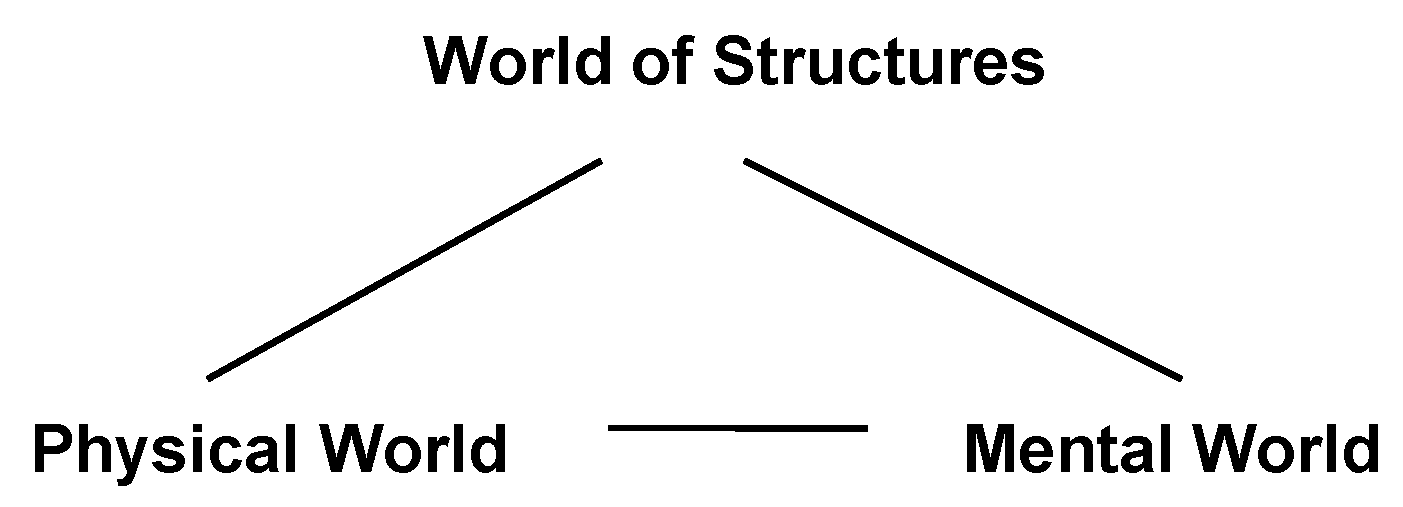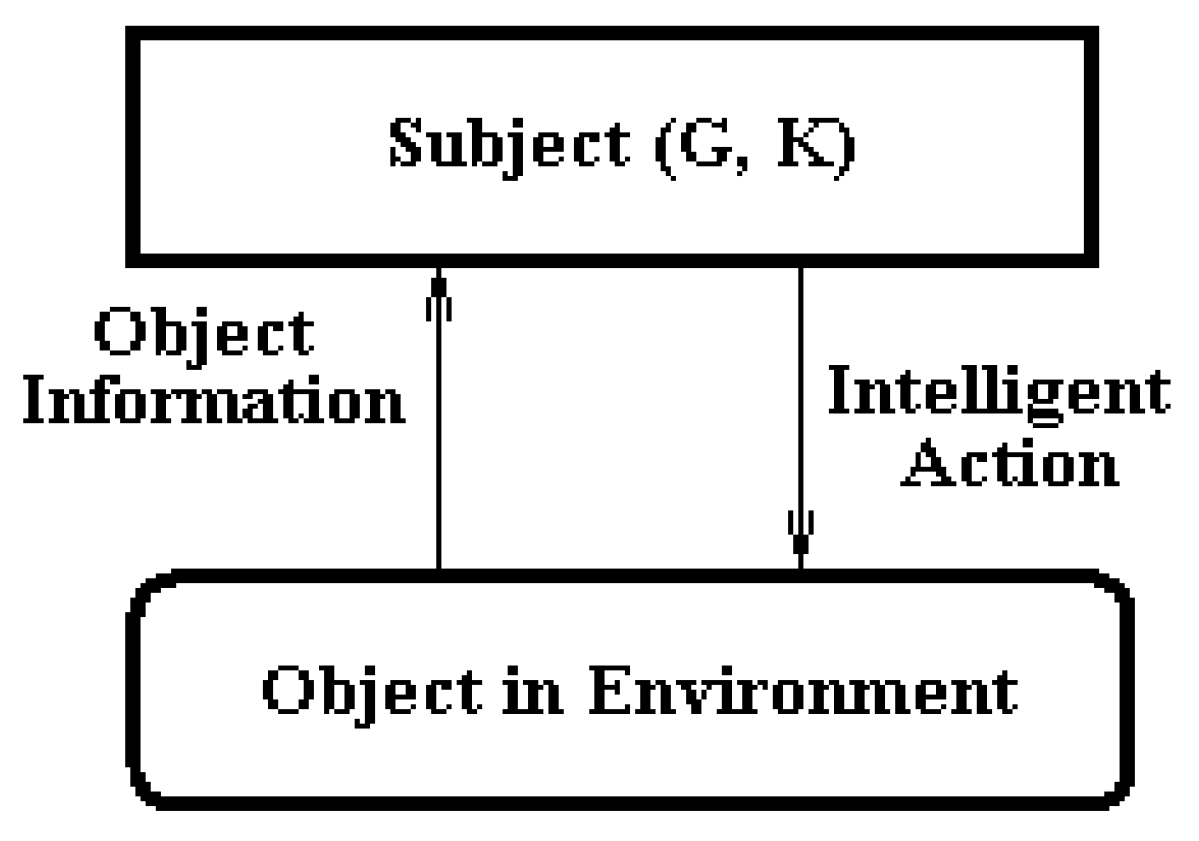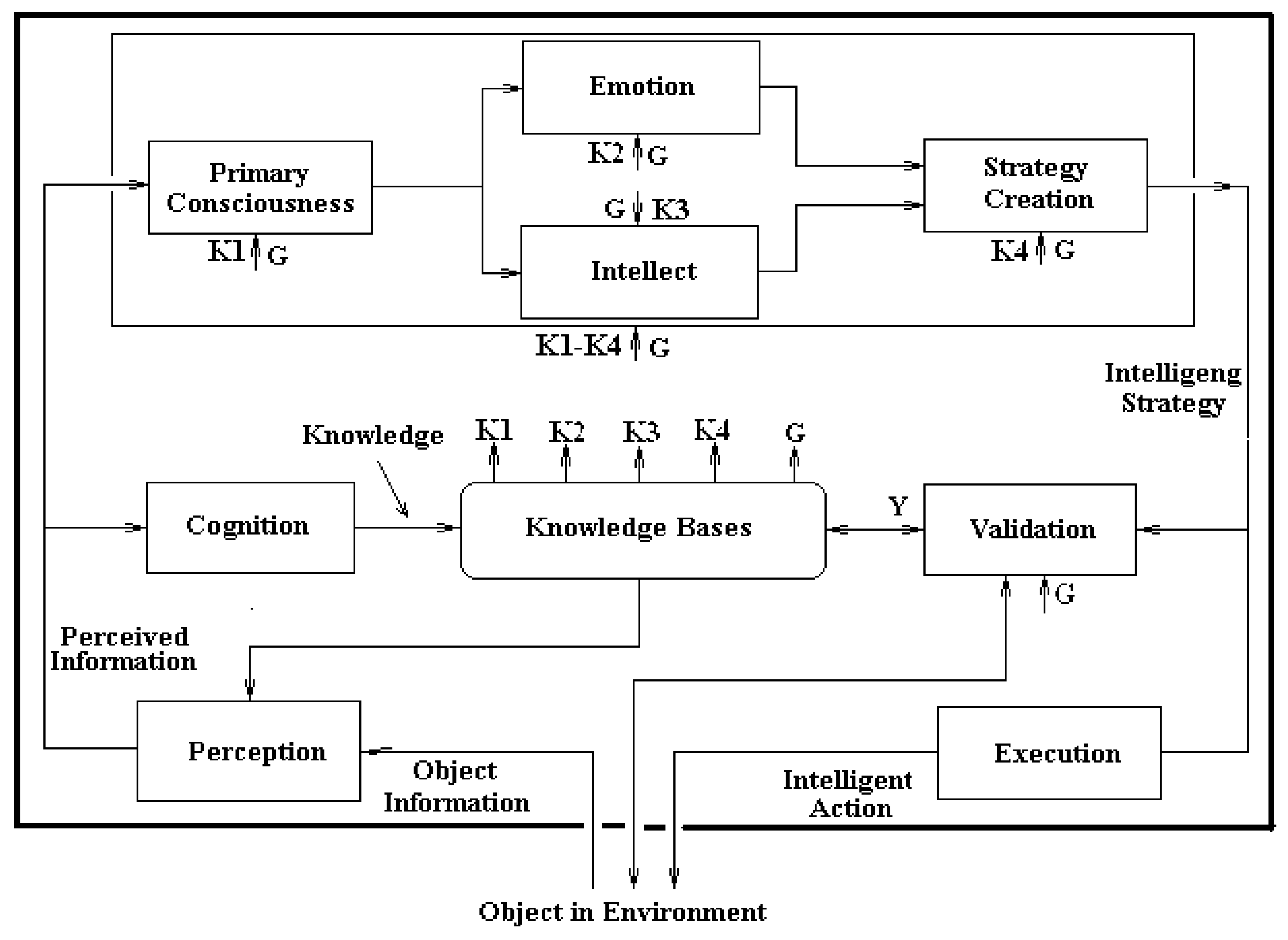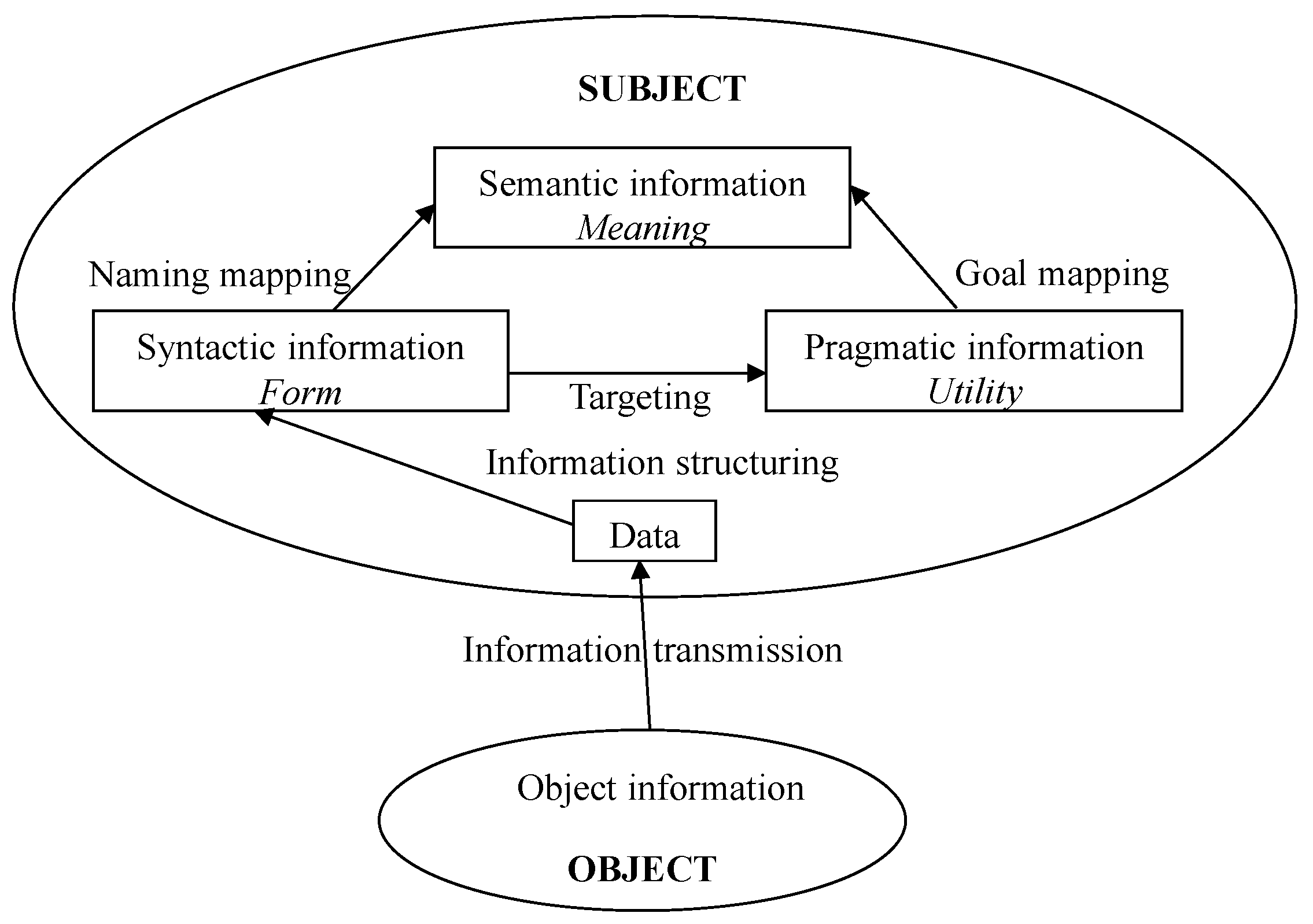Information Ecology in the Context of General Ecology
Abstract
:1. Introduction
2. A Brief History of Ecological Studies
3. Fundamentals of General Ecology
- –
- Physical ecosystems comprise physical systems, arrangements and processes as its elements, parts and components
- –
- Mental ecosystems encompass mental schemas, arrangements and processes as its elements, parts and components
- –
- Structure ecosystems consist of structures of physical systems, arrangements and processes as its elements, parts and components
- –
- The physical constituent of the ecological system and its environment comprises physical systems, arrangements and processes
- –
- The structural constituent of the ecological system and its environment consists of structures of physical systems, arrangements and processes
- –
- The mental constituent of the ecological system and its environment encompasses mental schemas, arrangements and processes
- –
- A section in the physical (mental or structural) space (or a region on a scientific sphere), i.e., it is presumed that all elements and components of an ecological system belong to a definite section in the space (or a definite region on a scientific sphere).
- –
- The key categories of its elements, parts and components, i.e., it is determined what elements, parts and components of the specified ecological system are treated as the most imperative from the perspective of ecological studies.
- –
- The principal sorts of connections and interrelations between its elements, parts and components, including processes as dynamic connections, i.e., it is determined what relationships, ties and processes in the specified ecological system are treated the most basic from the perspective of ecological studies.
- –
- A class R of regions in the space, for example, forest region or desert region on the Earth
- –
- A class E of elements and components, for example, animals living in the region, plants growing in the region and abiotic elements, such as rivers or mountains, in the region
- –
- A class C of ties and relations between its elements/components including processes as dynamic ties
- Primary or leading parts, components and elements
- Secondary or auxiliary parts, components and elements
- Tertiary or background parts, components and elements
4. Methodological Issues of Information Studies
5. Ecological Approach as a New Methodology for Information Studies
5.1. The Concept of Information Ecology
5.2. Information Ecology as a Research Model
- Subject can be any intelligent system possessing knowledge and goals and treated from the information perspective although the most typical, most characteristic, and thus, the most meaningful, subjects are human beings who have complex goals and enough knowledge.
- Object can be any information processing system imbedded in its environment.
- Interaction consists of processes that go between the Subject and the Object.
- The Way produces one;
- one begets two;
- two begets three;
- and three brings about the whole world.
- (1)
- It has to be aimed at achieving the subject’s goal;
- (2)
- The interaction of the system and the environment should be harmonious.
- (1)
- The object information is converted to perceived information by perception mechanisms.
- (2)
- The perceived information is transformed into knowledge by the mind.
- (3)
- The perceived information, complemented by the related knowledge and directed by subject’s goals, is successively generates consciousness, emotions, and intellect, which are integrated in the brain and in turn, generate intelligent strategy.
- (4)
- Intelligent strategy is converted to intelligent action via execution mechanisms.
- (5)
- The created intelligent action is finally applied to the object, forming the first cycle the subject–object interaction.
5.3. Ecological Approach in Information Studies
5.4. Basic Relations and Processes in Information Ecological Systems
- (2-1)
- If the subject has experienced the object before and pragmatic object information has been stored in the subject’s memory as {syntactic (n), pragmatic (n)} where n is the name of the object, then it is very easy to produce pragmatic information via recalling, that is, by using the syntactic information obtained at step (1) in the same way as key words are used for retrieving information from the memory. As long as the “syntactic (n)” is matched with the key words, pragmatic (n), which is related to syntactic (n), is pragmatic object information.
- (2-2)
- If the object is a new one and the subject has never experienced it before having no information in the form {syntactic (n), pragmatic (n)} stored in memory. Then there is no possibility to produce the pragmatic information through recalling. In this case, the pragmatic information can be produced via direct testing—making a real experiment to see if the object has any utility related to the subject’s goal.
6. Conclusions
Acknowledgments
Author Contributions
Conflicts of Interest
References
- Burgin, M. Theory of Information: Fundamentality, Diversity and Unification; World Scientific: New York, NY, USA, 2010. [Google Scholar]
- Mazur, M. Jakosciowa Teoria Informacji; PAN: Warszawa, Poland, 1970. (In Polish) [Google Scholar]
- Shannon, C.E. The Mathematical Theory of Communication. Bell Syst. Tech. J. 1948, 27, 379–423. [Google Scholar] [CrossRef]
- Shannon, C.E. Collected Papers; Sloane, N.J.A., Wyner, A.D., Eds.; IEEE Press: New York, NY, USA, 1993. [Google Scholar]
- Dretske, F.I. Knowledge and the Flow of Information; Basil Blackwell: Oxford, UK, 1981. [Google Scholar]
- Dretske, F. Précis of Knowledge and the Flow of Information. Behav. Brain Sci. 1983, 6, 55–63. [Google Scholar] [CrossRef]
- Barwise, J.; Seligman, J. Information Flow: The Logic of Distributed Systems; Cambridge Tracts in Theoretical Computer Science 44; Cambridge University Press: Cambridge, UK, 1997. [Google Scholar]
- Burgin, M. Information Operators in Categorical Information Spaces. Information 2010, 1, 119–152. [Google Scholar] [CrossRef]
- Burgin, M. Weighted E-Spaces and Epistemic Information Operators. Information 2014, 5, 357–388. [Google Scholar] [CrossRef]
- Zhong, Y.X. Principles of Information Science; BUPT Press: Beijing, China, 1988. (In Chinese) [Google Scholar]
- Zhong, Y.X. The Law of “Information Conversion and Intelligence Creation”. In Information Studies and the Quest for Transdisciplinarity; World Scientific: New York, NY, USA, 2017. [Google Scholar]
- Capurro, R. Towards an Information Ecology. In Information and Quality; Wormell, I., Ed.; Taylor Graham: London, UK, 1990; pp. 122–139. [Google Scholar]
- Davenport, T.H.; Prusak, L. Information Ecology; Oxford University Press: Oxford, UK, 1997. [Google Scholar]
- Burgin, M. Principles of General Ecology. Proceedings 2017, 1, 148. [Google Scholar] [CrossRef]
- Willis, A.J. The Ecosystem: An Evolving Concept Viewed Historically. Funct. Ecol. 1997, 11, 268–271. [Google Scholar] [CrossRef]
- Tansley, A.G. The use and abuse of vegetational concepts and terms. Ecology 1935, 16, 284–307. [Google Scholar] [CrossRef]
- Odum, E.P. Fundamentals of Ecology; Cengage Learning: Boston, MA, USA, 2004. [Google Scholar]
- Weaver, J.E.; Clements, F.E. Plant Ecology; McGraw-Hill Book Company: New York, NY, USA, 1938. [Google Scholar]
- Young, G.L. Human ecology as an interdisciplinary concept: A critical inquiry. Adv. Ecol. Res. 1974, 8, 1–105. [Google Scholar]
- Shrivastava, P. Knowledge Ecology: Knowledge Ecosystems for Business Education and Training. 1998. Available online: http://www.facstaff.bucknell.edu/shrivast/KnowledgeEcology.html (accessed on 18 May 2017).
- Malhotra, Y. Knowledge Management for Organizational White Waters: An Ecological Framework. Knowl. Manag. 1999, 2, 18–21. [Google Scholar]
- Pór, G. Nurturing Systemic Wisdom through Knowledge Ecology. Syst. Think. 2000, 11, 1–5. [Google Scholar]
- Bray, D.A. Knowledge Ecosystems: A Theoretical Lens for Organizations Confronting Hyperturbulent Environments. In Organizational Dynamics of Technology-Based Innovation: Diversifying the Research Agenda; Springer: Medford, MA, USA, 2007; pp. 457–462. [Google Scholar]
- Hai, D.; Farookh, H.; Chang, E. A Human-Centered Semantic Service Platform for the Digital Ecosystems Environment. World Wide Web 2010, 13, 75–103. [Google Scholar]
- Hai, D.; Farookh, H.; Chang, E. A framework for discovering and classifying ubiquitous services in digital health ecosystems. J. Comput. Syst. Sci. 2011, 77, 687–704. [Google Scholar]
- Hai, D.; Farookh, H.; Chang, E. Semantic service matchmaking for Digital Health Ecosystems. Knowl.-Based Syst. 2011, 24, 761–774. [Google Scholar]
- Hai, D.; Farookh, H.; Chang, E. A service concept recommendation system for enhancing the dependability of semantic service matchmakers in the service ecosystem environment. J. Netw. Comput. Appl. 2011, 34, 619–631. [Google Scholar]
- Hai, D.; Farookh, H. Service-requester-centered service selection and ranking model for digital transportation ecosystems. Computing 2015, 97, 79–102. [Google Scholar]
- Corallo, A.; Passiante, G.; Prencipe, A. (Eds.) The Digital Business Ecosystem; Edward Elgar Publishing: Northampton, MA, USA, 2007. [Google Scholar]
- Nachira, F.; Nicolai, A.; Dini, P.; Le Louarn, M.; Rivera Leon, L. (Eds.) Digital Business Ecosystems; European Commission: Brussels, Belgium, 2008. [Google Scholar]
- Burgin, M. Techno-Ecology and Problems of Education. In Intellectual Innovations in Society and Development of Education; NGU: Novosibirsk, Russia, 1997; pp. 175–178. (In Russian) [Google Scholar]
- Damiani, E.; Uden, L.; Trisnawaty, W. The future of E-learning: E-learning ecosystem. In Proceedings of the 2007 Inaugural IEEE-IES Digital EcoSystems and Technologies Conference (DEST ’07), Cairns, Australia, 21–23 February 2007. [Google Scholar]
- Bateson, G. Steps to an Ecology of Mind; Jason Aronson Inc.: St. Albans, UK, 1973. [Google Scholar]
- Bookchin, M. The Ecology of Freedom; AK Press: Stirling, UK, 2005. [Google Scholar]
- Burgin, M. Structural Reality; Nova Science Publishers: New York, NY, USA, 2012. [Google Scholar]
- Herbert, N. Quantum Reality: Beyond the New Physics; Anchor Books: New York, NY, USA, 1987. [Google Scholar]
- Burgin, M. Ideas of Plato in the context of contemporary science and mathematics. Athens J. Hum. Arts 2017, 4, 161–182. [Google Scholar]
- Sneed, J.D. The Logical Structure of Mathematical Physics; D. Reidel: Dordrecht, The Netherlands, 1971. [Google Scholar]
- Suppe, F. (Ed.) The Structure of Scientific Theories; University of Illinois Press: Urbana, IL, USA, 1974. [Google Scholar]
- Burgin, M.; Kuznetsov, V. Introduction to Modern Exact Methodology of Science; International Science Foundation: Moscow, Russia, 1994. (In Russian) [Google Scholar]
- Burgin, M. Theory of Knowledge; World Scientific: New York, NY, USA, 2016. [Google Scholar]
- Zhong, Y.X. Principles of Advanced Artificial Intelligence; Science Press: Beijing, China, 2014. (In Chinese) [Google Scholar]
- Zhong, Y.X. Information Ecology. Proceedings 2017, 1, 200. [Google Scholar] [CrossRef]
- Burgin, M. Theory of Named Sets; Mathematics Research Developments; Nova Science: New York, NY, USA, 2011. [Google Scholar]
- Burgin, M. Bidirectional named sets as structural models of interpersonal communication. Proceedings 2017, 1, 58. [Google Scholar] [CrossRef]
- Burgin, M. Theory of Named Sets as a Foundational Basis for Mathematics. In Proceedings of the International Symposium on Structures in Mathematical Theories (SSMT-90), San Sebastián, Spain, 25–29 September 1990; pp. 417–420. [Google Scholar]
- Burgin, M. Named Sets as a Basic Tool in Epistemology. Epistemologia 1995, 18, 87–110. [Google Scholar]
- Zhong, Y.X. Structuralism? Functionalism? Behaviorism? Or Mechanism? Looking for Better Approach to AI. Int. J. Intell. Comput. Cybern. 2008, 1, 325–336. [Google Scholar] [CrossRef]
- Zhong, Y.X. Principles of Information Conversion: Integrative Theory of Information, Knowledge, and Intelligence. Sci. Bull. 2013, 58, 1300–1306. [Google Scholar] [CrossRef]






© 2018 by the authors. Licensee MDPI, Basel, Switzerland. This article is an open access article distributed under the terms and conditions of the Creative Commons Attribution (CC BY) license (http://creativecommons.org/licenses/by/4.0/).
Share and Cite
Burgin, M.; Zhong, Y. Information Ecology in the Context of General Ecology. Information 2018, 9, 57. https://doi.org/10.3390/info9030057
Burgin M, Zhong Y. Information Ecology in the Context of General Ecology. Information. 2018; 9(3):57. https://doi.org/10.3390/info9030057
Chicago/Turabian StyleBurgin, Mark, and Yixin Zhong. 2018. "Information Ecology in the Context of General Ecology" Information 9, no. 3: 57. https://doi.org/10.3390/info9030057
APA StyleBurgin, M., & Zhong, Y. (2018). Information Ecology in the Context of General Ecology. Information, 9(3), 57. https://doi.org/10.3390/info9030057




